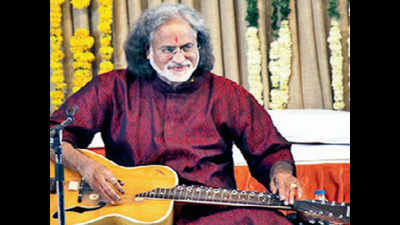- News
- City News
- ahmedabad News
- Keatsian truth, Pandit Vishwa Mohan Bhatt Veena’ beauty
Trending
This story is from January 8, 2017
Keatsian truth, Pandit Vishwa Mohan Bhatt Veena’ beauty
Pandit Vishwa Mohan Bhatt — the creator of the Mohan Veena — planned to play Raga Hemant, on Friday, Day 6 of Saptak. About an hour before his performance, he told TOI that Hemant was the specialty of the Maihar Gharana into which he was initiated by his guru, the sitar colossus Pandit Ravi Shankar.

Pandit Vishwa Mohan Bhatt. Photo: TOI
AHMEDABAD: Pandit Vishwa Mohan Bhatt — the creator of the Mohan Veena — planned to play Raga Hemant, on Friday, Day 6 of Saptak. About an hour before his performance, he told TOI that Hemant was the specialty of the Maihar Gharana into which he was initiated by his guru, the sitar colossus Pandit Ravi Shankar. “Hemant is not really a conventional raga,” Pandit Bhatt said. From Panditji’s observations, it appeared that despite its name (Hemant means winter), the raga tends to muse about love, with a smile on its face.
While tuning his Mohan Veena on the stage, Panditji changed his mind.He let Hemant ponder on courtship, and chose to play Raga Bihag instead. What rasikas experienced was the result of a fresh intuition. Like the beam from a lighthouse, Bihag illuminates sentiments in a gentle sweep. A popular Bollywood song, “Koi gata main so jata” (sung by Yesudas in the 1970s film “Alaap”) reflects the raga’s flashes.
Panditji made Bihag’s light slide to that point where truth meets beauty (in an affirmation of the Keatsian idea). The alaap nudged rasikas to sway to their sides as though Panditji’s playing had made them spiritually supple. In the faster phase, Mohan Veena’s relaxed chanting became more urgent as Panditiji’s fingers pulsated on the strings till the notes danced like a victorious heart.
After the concert Panditji told TOI: “Countless factors determine what we play. In this case, the raga I chose in the end was uniquely suited to the Mohan Veena.” But rasikas will agree that the instrument that produced the masterwork on the Saptak stage was Panditji’s saadhana. Although Indian classical musicians can leave the decision about their presentation till the very moment when they face the audience, great art that seems to come impromptu is the product of long years of rigorous self-inquiry.
While tuning his Mohan Veena on the stage, Panditji changed his mind.He let Hemant ponder on courtship, and chose to play Raga Bihag instead. What rasikas experienced was the result of a fresh intuition. Like the beam from a lighthouse, Bihag illuminates sentiments in a gentle sweep. A popular Bollywood song, “Koi gata main so jata” (sung by Yesudas in the 1970s film “Alaap”) reflects the raga’s flashes.
Panditji made Bihag’s light slide to that point where truth meets beauty (in an affirmation of the Keatsian idea). The alaap nudged rasikas to sway to their sides as though Panditji’s playing had made them spiritually supple. In the faster phase, Mohan Veena’s relaxed chanting became more urgent as Panditiji’s fingers pulsated on the strings till the notes danced like a victorious heart.
After the concert Panditji told TOI: “Countless factors determine what we play. In this case, the raga I chose in the end was uniquely suited to the Mohan Veena.” But rasikas will agree that the instrument that produced the masterwork on the Saptak stage was Panditji’s saadhana. Although Indian classical musicians can leave the decision about their presentation till the very moment when they face the audience, great art that seems to come impromptu is the product of long years of rigorous self-inquiry.
End of Article
FOLLOW US ON SOCIAL MEDIA










